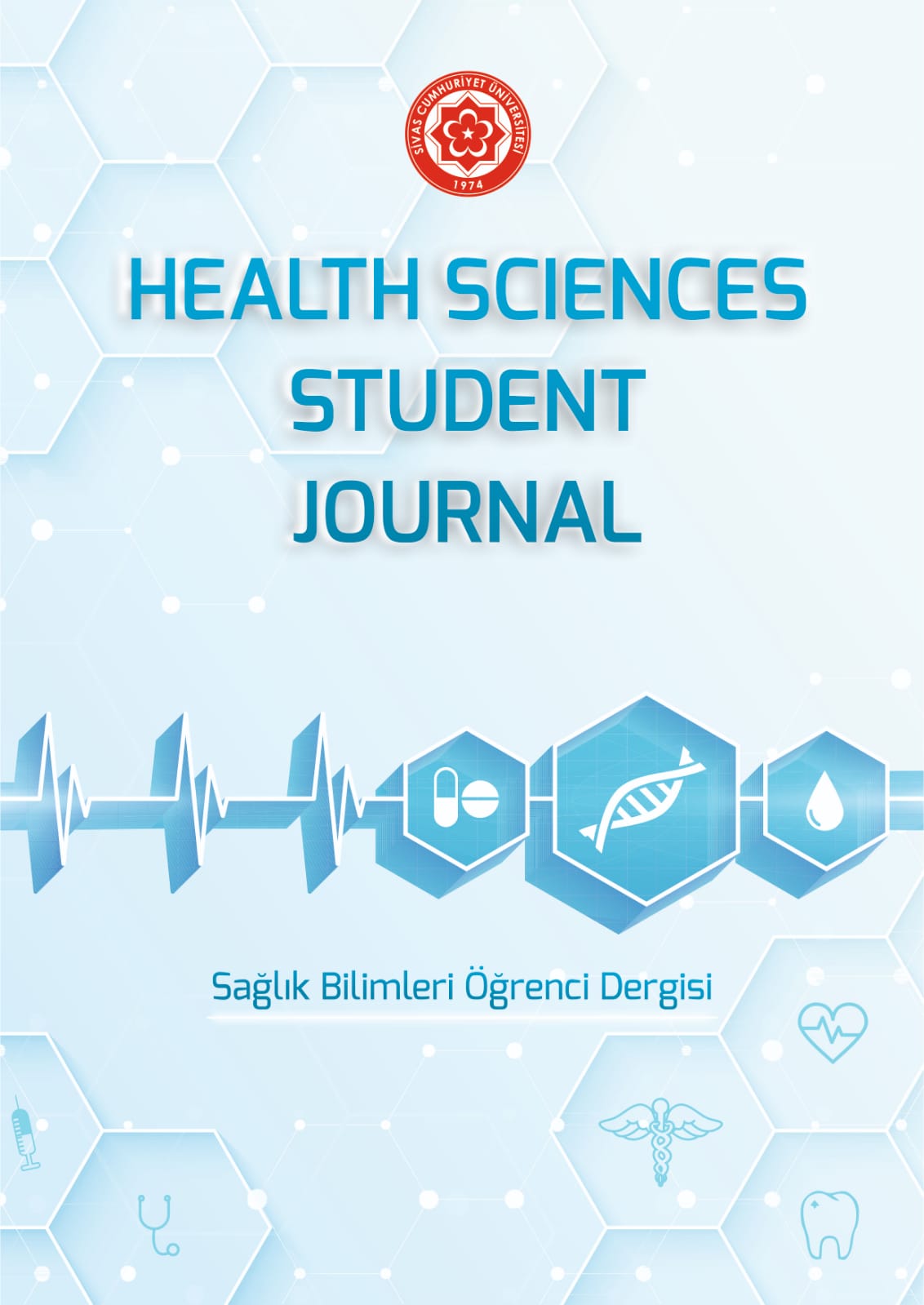![]()
Complicated liver cyst hydatid disease: A case report
Yazarlar: Melih Turan GÜRLEMEZ1, Muhammed GÖMEÇ2
Corresponding author
1Melih Turan Gürlemez, Sivas Cumhuriyet Üniversitesi Tıp Fakültesi Dönem 4, Sivas, Türkiye
E-mail: mgurlemez77@gmail.com
Other authors
2Sivas Cumhuriyet Üniversitesi Tıp Fakültesi Genel Cerrahi Anabilim Dalı, Sivas, Türkiye
ÖZET
Giriş: Hidatik kist hastalığı Echinococcus Granulosus’un neden olduğu, karaciğer ve akciğer başta olmak üzere tüm organları tutabilen paraziter bir hastalıktır. Özellikle gelişmekte olan ve geri kalmış ülkelerde daha sık görülmektedir. En sık görülen karaciğer kist hidatiğinin komplike vakalara dönüşmesi halinde mortalite oranı artmaktadır.
Olgu: Olgumuz; 45 yaşında kadın hastadır. Ara ara olan karın sağ üst kadran ağrıları nedeni ile takip edilen hastanın sarılık, bulantı ve kusma şikayetlerinin olması nedeni ile kliniğe başvurdu. Hastanın yapılan radyolojik incelemelerinde komplike karaciğer kist hidatiğinin olduğu tespit edildi. Hasta acil şartlar altında ameliyata alındı, kolesistektomi ve karaciğer sol lobektomi yapıldı. Postoperatif takiplerinde komplikasyon gelişmedi. Albendezol tedavisi ile takip edildi. Uzun dönem takiplerde herhangi bir patolojik bulguya rastlanmadı.
Anahtar Kelimeler: Echinococcus granulosus, karaciğer kist hidatiği, karaciğer rezeksiyonu; komplike kist hidatik.
ABSTRACT
Introdoction: Hydatid cyst disease is a parasitic disease caused by Echinococcus Granulosus that can affect all organs, especially the liver and lungs. It is more common in developing and underdeveloped countries. If the most common liver hydatid cyst turns into complicated cases, the mortality rate increases.
Case presentation: Our case; 45 years old female patient. The patient, who was followed up due to intermittent abdominal pain in the right upper quadrant, presented to the clinic with complaints of jaundice, nausea and vomiting. Complicated hepatic hydatid cyst was detected in the radiological examinations of the patient. The patient was operated under emergency conditions, cholecystectomy and left liver lobectomy were performed. There were no complications in the postoperative follow-up. He was followed up with albendezole treatment. No pathological finding was found in the long-term follow-up.
Keywords: Echinococcus granulosus, hydatid cyst of the liver; resection of the liver, hydatid cyst of the complex.
How to Cite (APA 7)
Gurlemez, M. T., Gomec, M. (2021). Komplike karaciğer kist hidatik hastalığı: Olgu sunumu. Health Sciences Student Journal, 1(1), 30-33. https://healthssj.com/komplike-karaciger-kist-hidatik-hastaligi-olgu-sunumu/
KAYNAKÇA/REFERENCES
1. Albayrak, D., Sezer, Y., A. İ.-B.M., & 2008, undefined.(n.d.). Karaciğer kist hidatik olgularımız. Balkanmedicaljournal.Org. Retrieved January 4, 2021, from http://www.balkanmedicaljournal.org/uploads/pdf/pdf_BMJ_ 1242.pdf
2. Tansel Çörtelekoðlu, A., Beþirli, K., Yüceyar, L., Bozkurt, K., Kaynak, K., Tüzün, H., Gürel Sayýn Ýstanbul Üniversitesi Cerrahpaþa Týp Fakültesi, A., Damar Cerrahisi Ana Bilim Dalý, K., Üniversitesi Cerrahpaþa Týp Fakültesi, Ý., Cerrahisi Ana Bilim Dalý, G., & ve Reanimasyon Ana Bilim Dalý, A. (n.d.). Atipik Yerleþimli Kist Hidatik Hydatıd Cyst Wıth Unusual Localızatıon.
3. Kornaros, S. E., & Aboul-Nour, T. A. (1996). Frank intrabiliary rupture of hydatid hepatic cyst: Diagnosis and treatment. Journal of the American College of Surgeons, 183(5), 466–470. https://europepmc.org/article/med/8912615
4. Mınkarı, & T. (1988). Alveolar kist. Cagdas Cerrahi Dergisi (J Curr Surg), 2, 209–240. https://ci.nii.ac.jp/naid/10006821019
5. Bedirli, A., Sakrak, O., Sozuer, E. M., Kerek, M., & Ince, O. (2002). Surgical management of spontaneous intrabiliary rupture of hydatid liver cysts. Surgery Today, 32(7), 594–597. https://doi.org/10.1007/s005950200107
6. Kayaalp, C., Bostanci, B., Yol, S., & Akoglu, M. (2003). Distribution of hydatid cysts into the liver with reference to cystobiliary communications and cavity-related complications. American Journal of Surgery, 185(2), 175–179. https://doi.org/10.1016/S0002-610(02)01202-3
7. Wu, X., Xin, W., & Zhao, S. Y. (1997). 37 patients with hepatic hydatid cyst rupturing into choledochus. Zhonghua Wai Ke Za Zhi [Chinese Journal of Surgery], 35(5), 279–280. https://europepmc.org/article/med/10374561
8. Gomez i Gavara, C., López-Andújar, R., Belda Ibáñez, T., Ramia Ángel, J. M., Moya Herraiz, Á., Orbis Castellanos, F., Pareja Ibars, E., & San Juan Rodríguez, F. (2015). Review of the treatment of liver hydatid cysts. World Journal of Gastroenterology, 21(1), 124–131. https://doi.org/10.3748/wjg.v21.i1.124
9. Akcan, A., Akyildiz, H., Artis, T., Ozturk, A., Deneme, M. A., Ok, E., & Sozuer, E. (2007). Peritoneal perforation of liver hydatid cysts: Clinical presentation, predisposing factors, and surgical outcome. World Journal of Surgery, 31(6), 1284–1291. https://doi.org/10.1007/s00268-007-9024-4
10. Yorganci, K., & Sayek, I. (2002). Surgical treatment of hydatid cysts of the liver in the era of percutaneous treatment. American Journal of Surgery, 184(1), 63–69. https://doi.org/10.1016/S0002-9610(02)00877-2
